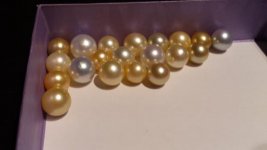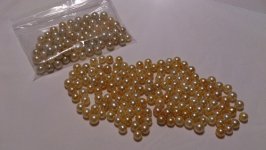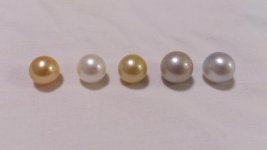katbadness
New Member
Hi guys,
This is my first post, though I've lurked for a few months now.
I'm a newbie currently on assignment to write about Indonesian SSP. I'm Indonesian, btw (hello to my fellow countrymen! I know you guys are out there! ).
).
First I want to thank people in this forum - the experts, the consumers, who have shared invaluable information that greatly helped me in my research! I am indebted to you. Some of the things I found here I can find nowhere else - especially since many of these said people have hands-on experience.
I don't know if this question belongs in this category - so feel free to move this thread somewhere else.
From what I've read, the gold-lipped and the silver-lipped Pinctada Maxima are really the same species. I also read that the gold-lipped predominantly inhabits the waters of the southern Philippines, and the silver-lipped can be found in the northern Australian coast. There's a missing information about what's in Indonesia, I thought, as Indonesia lies just in between the 2 countries.
Can I assume that Indonesia hosts both types of P. Maxima? Is there a specific habitat distribution range to these types of oysters (i.e. gold-lipped to the West, silver-lipped to the East, etc)? I am referring to Rusty's post on https://www.pearl-guide.com/forum/showthread.php?t=5271&page=4.
I also read somewhere that the gold tint is due to a certain salinity of the sea water. Is this another factor that causes the Pinctada Maxima in the north of the equator (so to speak) to produce more of the golden colors?
What I'm trying to find out is the color range of the pearls coming out of Indonesian waters, and why that is. And the difference between colors produced in the Philippines and Australia vs those that came out of Indonesian oysters, if any.
I may be shooting myself in the foot by trying to be too technical in my writing, but if anything the answers will sate my curiosity.
Thanks in advance guys.
--sintha
This is my first post, though I've lurked for a few months now.
I'm a newbie currently on assignment to write about Indonesian SSP. I'm Indonesian, btw (hello to my fellow countrymen! I know you guys are out there!
First I want to thank people in this forum - the experts, the consumers, who have shared invaluable information that greatly helped me in my research! I am indebted to you. Some of the things I found here I can find nowhere else - especially since many of these said people have hands-on experience.
I don't know if this question belongs in this category - so feel free to move this thread somewhere else.
From what I've read, the gold-lipped and the silver-lipped Pinctada Maxima are really the same species. I also read that the gold-lipped predominantly inhabits the waters of the southern Philippines, and the silver-lipped can be found in the northern Australian coast. There's a missing information about what's in Indonesia, I thought, as Indonesia lies just in between the 2 countries.
Can I assume that Indonesia hosts both types of P. Maxima? Is there a specific habitat distribution range to these types of oysters (i.e. gold-lipped to the West, silver-lipped to the East, etc)? I am referring to Rusty's post on https://www.pearl-guide.com/forum/showthread.php?t=5271&page=4.
I also read somewhere that the gold tint is due to a certain salinity of the sea water. Is this another factor that causes the Pinctada Maxima in the north of the equator (so to speak) to produce more of the golden colors?
What I'm trying to find out is the color range of the pearls coming out of Indonesian waters, and why that is. And the difference between colors produced in the Philippines and Australia vs those that came out of Indonesian oysters, if any.
I may be shooting myself in the foot by trying to be too technical in my writing, but if anything the answers will sate my curiosity.
Thanks in advance guys.
--sintha




